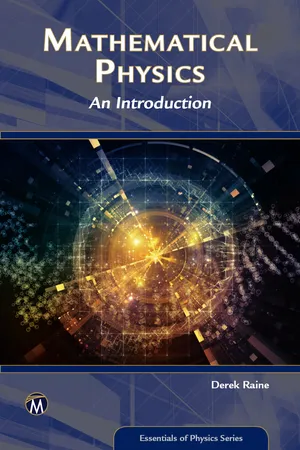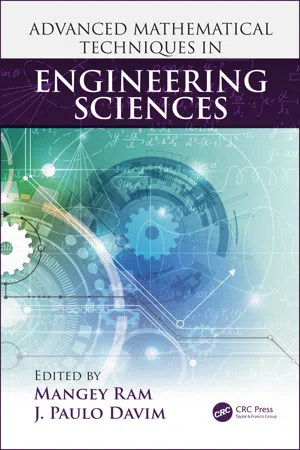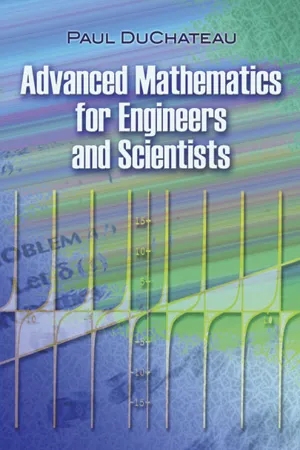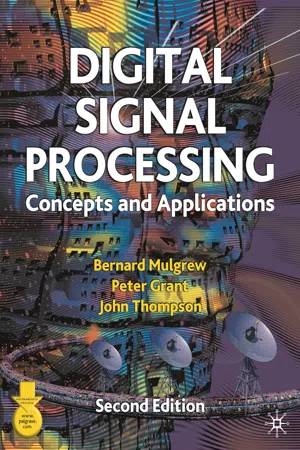Technology & Engineering
Half Range Fourier Series
The Half Range Fourier Series is a mathematical technique used to represent a periodic function as a sum of sines and cosines. It is particularly useful for functions that are defined only over half of the period, allowing for a more efficient representation. By using this series, engineers and technologists can analyze and manipulate periodic signals and waveforms in various applications such as signal processing and communications.
Written by Perlego with AI-assistance
Related key terms
Related key terms
1 of 4
Related key terms
1 of 3
5 Key excerpts on "Half Range Fourier Series"
- eBook - ePub
Essentials of Physics Series
An Introduction
- Derek Raine(Author)
- 2018(Publication Date)
- Mercury Learning and Information(Publisher)
ω would have a much less discernible effect.Fourier methods are also commonly used in mathematical physics. In this chapter, we will focus on using them to solve differential equations, and the wave equation in particular. We will examine Fourier half range series and Fourier full range series, study some applications of Fourier series, then finish by introducing Fourier transforms and the convolution theorem.12.2.FOURIER HALF RANGE SINE SERIES
In Chapter 11 , we calculated the separable solutions for a wave on a string that is fixed at both ends, at x = 0 and at x = L. In general, the displacement of such a string iswhere each of the a n and b n for n = 1, 2, 3 . . . is an arbitrary constant that we can set once we know the boundary conditions for any given problem. The range 0 to L is called the half range because it is half the maximum wavelength or spatial period.Consider the case when the string is initially at rest and has initial displacement y (x , 0) = f (x ). Then, by substituting t = 0 into equation (12.2), we findGiven any physically reasonable function, f (x ), can we find the coefficients, b n , such that equation (12.3) is satisfied? Remarkably, yes! This is known as Fourier’s theorem.Equation (12.3) is the Fourier half range sine series of a function, f (x ). This is a very powerful result. It tells us that, within the range 0 to L , we can write any - Mangey Ram, J. Paulo Davim(Authors)
- 2018(Publication Date)
- CRC Press(Publisher)
chapter twoFourier series and itsapplications in engineering
Smita Sonker and Alka Munjal National Institute of Technology Kurukshetra Contents 2.1 Introduction 2.2 Periodic functions 2.3 Orthogonality of sine and cosine functions 2.4 Fourier series 2.5 Dirichlet’s theorem 2.6 Riemann–Lebesgue lemma 2.7 Term-wise differentiation 2.8 Convergence of Fourier series 2.9 Small order 2.10 Big “oh” for functions 2.11 Fourier analysis and Fourier transform 2.12 Fourier transform 2.13 Gibbs phenomenon 2.13.1 Gibbs phenomenon with an example 2.13.2 Results related to Gibbs phenomenon 2.14 Trigonometric Fourier approximation 2.15 Summability 2.15.1 Ordinary summability 2.15.2 Absolute summability 2.15.3 Strong summability 2.16 Methods for summability 2.17 Regularity condition 2.18 Norm 2.19 Modulus of continuity 2.20 Lipschitz condition 2.21 Various Lipschitz classes 2.22 Degree of approximation 2.23 Fourier series and music 2.24 Applications and significant uses References2.1 Introduction
Mathematics has its roots embedded within various streams of engineering and sciences. The concepts of the famous Fourier series were originated from the field of physics. The following two physical problems are the reasons for the origin of Fourier series:- Heat conduction in solid
- The motion of a vibrating string
Jean Baptiste Joseph Fourier (1768–1830) was the first physicist, mathematician, and engineer who developed the concepts of Fourier analysis in dealing with the problems of vibrations and heat transfer. He claimed that any continuous or discontinuous function of t could also be expressed as a linear combination of cos(t ) and sin(t ) functions.In the mathematical analysis, we do not usually get a full decomposition into the simpler things, but an approximation of a complex system is usually achieved by a more elementary system. When we truncate the Taylor series expansion of a function, we approximate the function by using the polynomial.- Paul DuChateau(Author)
- 2013(Publication Date)
- Dover Publications(Publisher)
x ) to the interval [−L, 0] as an even function. This leads to theHalf Range Cosine Series. We define the Fourier coefficients for f (x ) from (7.6). Then the Fourier series for f (x ) has the formWe refer to this as the half range Fourier cosine series for f (x ). If this series converges to f (x ) for x in [0, L ], then it converges everywhere to f2L, even; the even 2L -periodic extension of f (x ).In other cases, we may find it more convenient to extend f (x ) to the interval [−L , 0] as an odd function. Then we obtain:Half Range Sine Series . We define the Fourier coefficients for f(x) from (7.7). Then the Fourier series for f (x ) has the formWe refer to this as the half range Fourier sine series for f (x ). If this series converges to f (x ) in [0, L ], then it converges everywhere to f2L, odd ;the odd 2L -periodic extension of f (x ).When f (x ) is defined only on [0, L ], the choice for the extension of f (x ) to [−L , 0] is generally dictated by the application at hand.Example 7.2 Half Range Fourier Series
- Let f (x ) = x for 0 < x < π. Then using (7.7) to compute the sine series coefficients, we find
These are the Fourier coefficients we computed in Example 7.1(b) for the odd function ƒ (x ) = x on [−π, π]. Thus, when we write a half range sine series for a function ƒ defined on the half range, we are in fact writing the full Fourier series for the odd extension of ƒ to the full range.
- Similarly, if we use (7.6) to compute the cosine series coefficients for the half range function ƒ (x ) = x , we find
These are the coefficients we obtained in Example 7.1(c) for the even function ƒ (x ) = |x | on [−π, π]. This is consistent with the observation that when we write a half range cosine series for the half range function ƒ , we are in fact writing the Fourier series for the even extension of ƒ
- eBook - ePub
Digital Signal Processing
Concepts and Applications
- Bernard Mulgrew, Peter Grant, John Thompson(Authors)
- 2002(Publication Date)
- Bloomsbury Academic(Publisher)
n. Using the above relationships it is also straightforward to move back and forward between a trigonometric Fourier series representation and a complex Fourier series.1.3.4.Physical interpretationA variation of the Fourier series is the cosine series where:This form of the series can be obtained either by exploiting the Hermitian symmetry of the complex Fourier coefficients in equation (1.12) or by applying standard trigonometric identities to equation (1.6). It is seldom used but is included here because of the insight it gives into the meaning of the complex Fourier coefficients. It facilitates a physical interpretation of the complex Fourier coefficients.By definition, the series is used to represent a periodic signal as a sum of cosine waves. The frequencies of these cosine waves are: 0,ω0 , 2ω0 , 3ω0 , etc. The magnitude of the complex Fourier coefficient |Xn | is half the amplitude of the nth harmonic. The angle of the complex Fourier coefficient ∠ Xn is the phase shift associated with the nth harmonic. Thus the nth harmonic might be written as:2|Xn | cos(nω0 t + ∠ Xn )Figure 1.6(b) can be re-examined in this light. It represents the distribution of both amplitude and phase with harmonic number. It is commonly called a frequency spectrum. In this case it is a discrete spectrum because it only has values at the frequencies of the harmonics, i.e. nω0 .1.3.5.OrthogonalityBoth the trigonometric and complex Fourier representations are examples of orthogonal expansions. In particular, two periodic signals f1 (t) and f2 (t) are said to be orthogonal if their product integrated over one period is zero, i.e.:The superscript * denotes complex conjugate and is used to accommodate complex signals which can arise in radar and communications systems. In the complex Fourier series the basis functions exp( jω0 t), exp( j2ω0 t), . . ., exp( jnω0 t - eBook - ePub
- H. John Pain(Author)
- 2013(Publication Date)
- Wiley(Publisher)
only within the chosen interval . If applied outside that interval it will not follow the function but will periodically repeat the value of the function within the chosen interval. If we represent this interval by a Fourier cosine series the repetition will be that of an even function, if the representation is a Fourier sine series an odd function repetition will follow.Figure 10.4A Fourier series may represent a function over a selected half-interval. The general function in (a) is represented in the half-interval 0 < x < l /2 by f e , an even function cosine series in (b), and by f 0 , an odd function sine series in (c). These representations are valid only in the specified half-interval. Their behaviour outside that half-interval is purely repetitive and departs from the original functionSuppose now that we are interested in the behaviour of a function over only one-half of its full interval and have no interest in its representation outside this restricted region. In Figure 10.4a the function f (x ) is shown over its full space interval −l /2 to +l /2, but f (x ) can be represented completely in the interval 0 to +l /2 by either a cosine function (which will repeat itself each half-interval as an even function) or it can be represented completely by a sine function, in which case it will repeat itself each half-interval as an odd function. Neither representation will match f (x ) outside the region 0 to +l /2, but in the half-interval 0 to +l /2 we can writewhere the subscripts e and o are the even (cosine) or odd (sine) Fourier representations, respectively.The arguments of sines and cosines must, of course, be phase angles, and so far the variables x has been measured in radians. Now, however, the interval is specified as a distance and the variable becomes 2π x/l , so that each time x changes by l the phase angle changes by 2π
Index pages curate the most relevant extracts from our library of academic textbooks. They’ve been created using an in-house natural language model (NLM), each adding context and meaning to key research topics.
Explore more topic indexes
Explore more topic indexes
1 of 6
Explore more topic indexes
1 of 4




